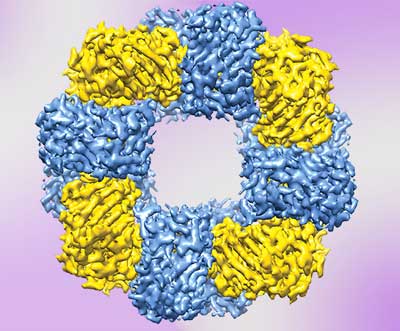| Jan 14, 2019 | |
Scientists coax proteins to form synthetic structures with method that mimics nature(Nanowerk News) Scientists have long dreamed of creating synthetic structures out of the same raw material that nature uses in living systems — proteins — believing such an advance would allow for the development of transformative nanomachines, for example, molecular cages that precisely deliver chemotherapy drugs to tumors or photosynthetic systems for harvesting energy from light. |
|
| Now a team of biologists from The University of Texas at Austin and the University of Michigan have invented a way to build synthetic structures from proteins, and just as in nature, the method is simple and could be used for a variety of purposes. | |
| “We think we can use these structures kind of like Legos to build bigger things,” said David Taylor, assistant professor of molecular biosciences at UT Austin and co-corresponding author on a new paper published in the journal Nature Chemistry ("Supercharging enables organized assembly of synthetic biomolecules"). “We also know some of the rules for modifying the basic recipe to make different types of building blocks.” | |
 |
|
| As a proof of concept, a team of researchers at the University of Texas at Austin built tiny structures that resemble two doughnuts stacked on top of each other by applying electrical charges to specific spots on naturally occurring proteins. (Image: University of Texas at Austin) | |
| As a proof of concept, the team built tiny structures that resemble two doughnuts stacked on top of each other by applying electrical charges to specific spots on naturally occurring proteins. Previous researchers have managed to create synthetic structures from proteins but only after painstakingly affixing something onto proteins or creating new proteins from scratch, making earlier methods complicated, time-intensive and limiting. | |
| By contrast, the new method, dubbed “SUpercharged PRotein Assembly (SuPrA),” mimics the way that proteins in living organisms work as they make the molecular machines that carry out the different functions of life: The structures in the new method are self-assembling and flexible. | |
| “Our approach takes a protein that doesn’t normally assemble, and gives it many potential sites where it might be able to, allowing it to ‘choose’ which fits the rest of its geometry and chemistry best,” said Anna Simon, a postdoctoral researcher in UT Austin’s Department of Molecular Biosciences and co-first author of the paper. “This is important because it gives us a way to semi-direct proteins to organize into larger structures without having to understand beforehand exactly how they will fit together.” | |
| The original concept for this new method was developed by Andy Ellington, associate director of UT Austin’s Center for Systems and Synthetic Biology, also a professor of molecular biosciences and the co-corresponding author on the study. | |
| To demonstrate their concept, the researchers started with green fluorescent protein, a standard protein used as a glowing tag in all sorts of biological experiments. They created two slightly different versions, using a never-before-attempted method: adding electrical charges to entice the protein to form discrete, symmetrical structures. One version had positive charges added at certain spots, and it was mixed in a solution with a second version that had negative charges at certain spots. | |
| The team found each version self-assembled into myriad tiny structures, or macromolecular complexes, each with the same number and arrangement of proteins. | |
| Because this method allows structures to be built from naturally occurring proteins, the researchers say it offers science a new tool that’s scalable, affordable and sustainable. | |
| “It’s like how people use 3D printers to make things out of materials they wouldn’t have used in the past,” Taylor said. “This new method gives us another option for materials. These materials are easily obtainable, inexpensive and not harmful to the environment.” |
| Source: University of Texas | |
|
Subscribe to a free copy of one of our daily Nanowerk Newsletter Email Digests with a compilation of all of the day's news. |
